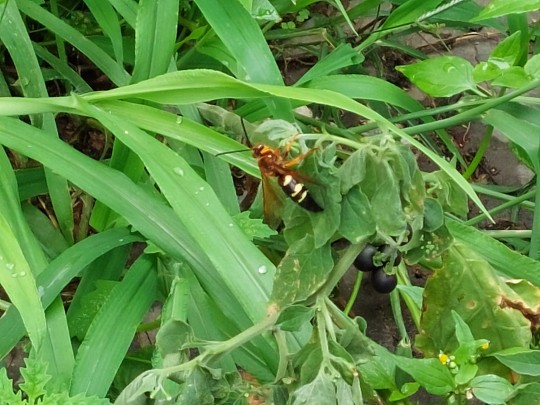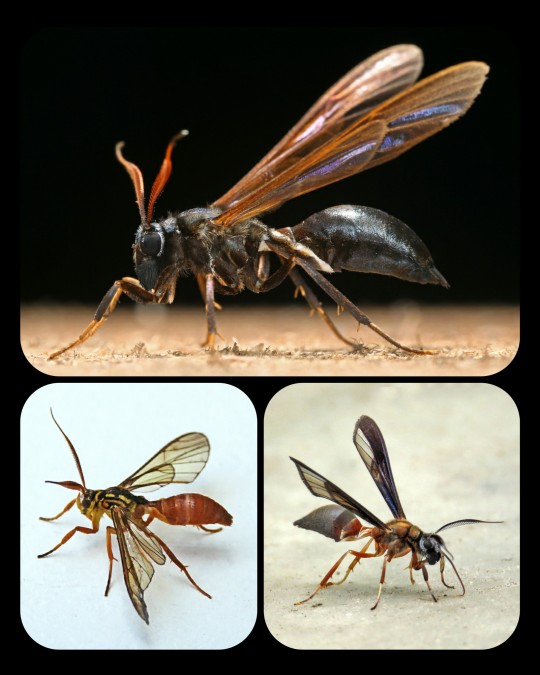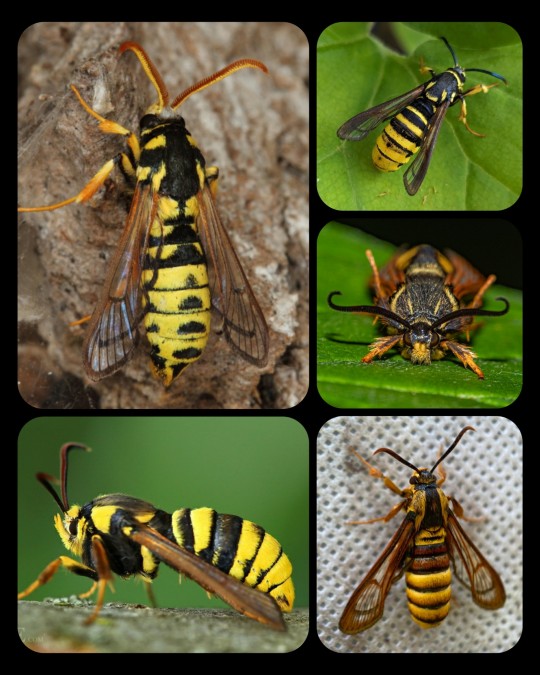#Hymenopterans
Text







my friends got me hooked on the newest trend: making transparent bug images
part 1/??
(all from photographs taken by me)
#inaturalist#naturalist#nature#ecology#zoology#biology#wildlife#insect#insects#bug#bugblr#entomology#bugs#insectblr#wasp#wasps#hymenoptera#hymenopteran#hymenopterans#lepidoptera#lepidopteran#beetle#beetles#butterfly#butterflies#moth#moths#pngposting#hawks photos
230 notes
·
View notes
Text

Eastern cicada-killer wasp I found a couple weeks ago.
(Not pictured: The turd in front of it)
#tagg actually talks#ironically while I've heard them I don't think I've actually encountered a live cicada before#just shed skins and a very large dead adult#hymenopterans#wasps#cicada killer#insects
13 notes
·
View notes
Text
Moths in Disguise: these are all just harmless moths that have developed the ability to mimic wasps, bees, and/or hornets

Top Row (left to right): Eusphecia pimplaeformis and Myrmecopsis polistes; Bottom Row: Pennisetia marginatum
Moths are exceptionally skilled when it comes to mimicry, and there are hundreds of moth species that rely on that tactic as a way to protect themselves from predators. Their disguises are numerous and varied, but hymenopteran mimicry is particularly common, especially among the moths that belong to subfamily Sesiidae and family Arctiinae.

Yellowjacket-Mimicking Moths: Pseudosphex sp. (top and bottom left) and Myrmecopsis polistes (bottom right)
Some of their disguises involve more than just a physical resemblance -- there are some moths that also engage in behavioral and/or acoustic mimicry, meaning that they can imitate the specific sounds and behaviors of their hymenopteran models. In some cases, these moths are so convincing that they can even fool the actual wasps/bees that they are mimicking.
Such a detailed and intricate disguise is unusual even among mimics, and researchers believe that it developed partly as a way to trick the wasps into treating the mimic like one of their own. Wasps tend to prey upon moths (and many other insects), but they are innately non-aggressive toward their own nest-mates, which are identified by sight -- so if the moth can convincingly impersonate its model, then it can avoid being eaten by predatory wasps.

Wasp-Mimicking Moths: Pseudosphex ichneumonea (top), Myrmecopsis sp. (bottom left), and Pseudosphex sp. (bottom right)
There are many moths that can also mimic hornets, bumblebees, and carpenter bees.

Hornet-Mimicking Moths: Eusphecia pimplaeformis (top left), Sesia apiformis (bottom left), Paranthrene simulans (top right), Pennisetia marginatum (middle right), and Sphecodoptera scribai (bottom left)

Bumblebee-Mimicking Moths: Hemaris tityus (top and bottom left) and Hemaris affinis (bottom right)
Moths are some of the most talented mimics in the natural world, as illustrated by their mastery of hymenopteran mimicry. But it's not just bees, hornets, and wasps -- there are many other forms of mimicry that can be found among moths, and the resemblance is often staggering.
Moths deserve far more credit than they receive, to be honest, because they are so incredibly interesting/diverse.
Sources & More Info:
Journal of Ecology and Evolution: A Hypothesis to Explain the Accuracy of Wasp Resemblances
Frontiers in Zoology: Southeast Asian clearwing moths buzz like their model bees
Royal Society Publishing: Moving like a model: mimicry of hymenopteran flight trajectories by clearwing moths of Southeast Asian rainforests
#lepidoptera#moths#Sesiidae#entomology#insects#animals#cool bugs#mimicry#nature#evolution#Arctiinae#bees#hymenoptera#hymenopteran mimic#wasp#bumblebee#acoustic mimicry#evolutionary arms race#I spend way too much time#reading about moths
403 notes
·
View notes
Text

my wasp girl whose hands have not been replaced with knives yet
#wasp#hymenopteran#mud dauber#paper wasp#furry#sfw furry#furry oc#bug#bug furry#art#digital art#drawing#digital drawing#rubidium (oc)
195 notes
·
View notes
Text

Honeybees
By: Oxford Scientific Films
From: Wild, Wild World of Animals: Insects & Spiders
1977
#honeybee#bee#hymenopteran#insect#arthropod#invertebrate#1977#1970s#Oxford Scientific Films#Wild Wild World of Animals
87 notes
·
View notes
Text










Wasp Nest (Bald-Faced Hornet)
While I yearn to showcase other types of insect nests found in the natural environment, it seems that all I've been able to easily find are Bald-Faced Hornet nests. Akin to the previous live nest showcase, the nest found here isn’t on my property. I was alerted to the presence of this nest (while only a few feet away) while on a long walk as the sun's heat began to relent. A large returning worker of the colony buzzed past me, flying straight to the entrance hole (which begins as a long, woody tube) at the bottom of the structure! I immediately leapt to the side to put some distance between myself and the nest, especially with the amount of workers at the entrance hole and walking along the nest's surface! They were likely on alert, but not necessarily agitated. Nevertheless, it's for the best not to get any closer to a nest than necessary while unprotected, even to take pictures. With the weather being so warm, I was fairly sweaty that day, and that can be very alluring to Wasps. It sounds strange, but sweat can be a good source of salt (an essential nutrient for a populated colony). That in mind, and given that the nest is just hanging from the tree so close to this house's porch, mailmen and pedestrians should trend carefully, as this large nest likely house hundreds of large Wasp individuals!
Generally speaking, Bald-Faced Hornets construct their nests such that the eventual entrance hole is situated at the bottom of the nest. Many individuals are returning there to prepare for the night's rest, but this nest also appears to have other passages in which Wasps can exit through or patrol. Specifically, the vents that run along the surface towards the top and bottom of the nest. Typically, vents in a structure like this would be used to manage airflow and heat, and provide a refuge to flying workers during rainfall, but it seems that this colony is also using them to allow individuals to navigate through other parts of the nest! While only an educated guess, it is unlikely that the workers would swarm from those ports as the entrance hole is wider with more room to take off immediately, rather than crawl to the nest's outer layer. Finally, it was only once I looked at these pictures at home (with no interference from inquisitive workers) that I noticed the array of colors of this nest. Generally Wasp nests are seen as grey or mottled brown, but the intricacies of this nest make it appear like it was stylized like a water-color painting and added into these pictures. The nest's color may have resulted from the different woods and plant materials gathered to build the nest. If that's the case, the layering work is quite neat and organized. Considering the coordination required of a colony to build the layers, it's a very impressive (and artful) feat!
Pictures were taken on July 28, 2024 with a Google Pixel 4.
#jonny’s insect catalogue#ontario insect#wasp nest#bald faced hornet#wasp#hymenoptera#bald faced hornet nest#hymenopteran nest#nest#insect#toronto#july2024#2024#entomology#nature#invertebrates#arthropods
38 notes
·
View notes
Text



gonna start slowly posting my art here . I’ve been more active on Instagram and forgetting abt tumblr so every day or so I’ll just post my older art here until I’m all caug up lol. have a sexy anatomically correct wasp rick and also a dumb little selfship comic I made
PROSHIP DNI
#rick and Morty#wasp rick#wasp rick fanart#rick sanchez#proship dni#I’m an entomology major so I made him more similar to actual wasps#he has hymenopteran antennae and a more accurate body plan (?)#his legs r supposed to be above his waist#maybe I change that#I need to kiss wasp rick on the mouth right now#also this drawing took me literally 16 hours in ibis paint and completely flopped on insta so it might happen here lmao#oops#it’s fine lmao
10 notes
·
View notes
Text
Happy and sleepy pantaloon bee in my moms garden!
#dasypoda#dasypoda hirtipes#bees#solitary bee#bee#video#kolo posts#hymenopteran#hymenoptera#pantaloon bee#melittidae
15 notes
·
View notes
Note
Ignore the bees.
no, no no no, i think i will continue not ignoring the bees 👁_👁
11 notes
·
View notes
Text
identifying moths to family more like. help me
#I have a moth in my brain she should be helping me. She should be making this so easy. That's most certainly how that works.#but instead she's like Lol. Lmao even#while I'm staring at wing venation on moths like Hhrhhhhh hrhngh aaaaaaaaggggg#the nefarious lasiocampidae. fuck you#clamtalk#bugposting#i'm studying for my classifications final and having a hell of a time . hemipterans I've got down pat Hymenopterans are a little meaner but#they're fine. Diptera also kinda sucks but I can get past it.#Lepidoptera however? Well fuck me. It's so many little brown moths
10 notes
·
View notes
Text
Thinking more about Hymenoptera Fantasy.
In ant society, aphids are seen as sacred animals, being made by Shuvak-amor (aka Shuvakamor, aka The Sun Queen) aka one of the goddesses of the ants.
According to ant folklore, Shuvak-amor made aphids for her love, Oumai-amir (aka Oumaiamir, the Moon Prince).
4 notes
·
View notes
Text








the transparent bugposting will continue until moral improves
part 7/??
(all from photographs taken by me)
#inaturalist#naturalist#nature#ecology#zoology#biology#wildlife#photography#nature photography#wildlife photography#hawks photos#animal photography#insect#insects#bug#bugblr#entomology#bugs#insectblr#wasp#wasps#hymenoptera#hymenopteran#hymenopterans#spider#spiders#spiderblr#arachnid#arachnids#pngposting
172 notes
·
View notes
Text
i think its so funny when people claim xenomorphs are males. no they're girl-things <3 especially the little runners and workers and praetorians
#closest to quote unquote male xeno was probably Big Chap from Alien 1979 but i think it was bc they hadn't fully perfected them yet#that would be with Aliens :)#they're ANTS. without drones aka no males. my beautiful parthenogenic space hymenopterans <3#mac rambles#my alien toys are all hidden in boxes so i hardly remember her at this rate :( autism LOSS
11 notes
·
View notes
Text

Pursuant to the ceratopsiants, my good friend Ben requested ceratopsian wasps and/or ceratopsian treehoppers. Exceeding my wildest expectations, Midjourney 6 somehow nailed both in one pass, albeit in the form of an outsized museum diorama. But hell, I'll TAKE WHAT I CAN GET
#ai exhibit display#panspermic styracosaurus wasp#extrasolar centrosaurine x hymenopteran chimera#tapirverse dinobugs ftw
6 notes
·
View notes
Text

Ants attacking a ladybug who was eating their treehopper livestock
By: Raymond A. Mendez
From: Natural History Magazine
1985
#ant#hymenopteran#insect#arthropod#invertebrate#ladybug#beetle#1985#1980s#Raymond A. Mendez#Natural History Magazine
39 notes
·
View notes
Text
fun fact: 'gaster' (or, rather, gastḗr) is ancient greek (and, more relevantly to myself, taxonomic-affix-ese) for stomach. it is also the word for the last part of a bee, wasp, or ant's abdomen. i have no idea if this means anything.
#....that was a lie. naturally‚ the obvious conclusion drawn from this information is that wd 'wing ding' gaster is a hymenopteran‚#(/joke. obviously. Unless)#(here's how bug can still win--)#spire rambles#utdr
2 notes
·
View notes